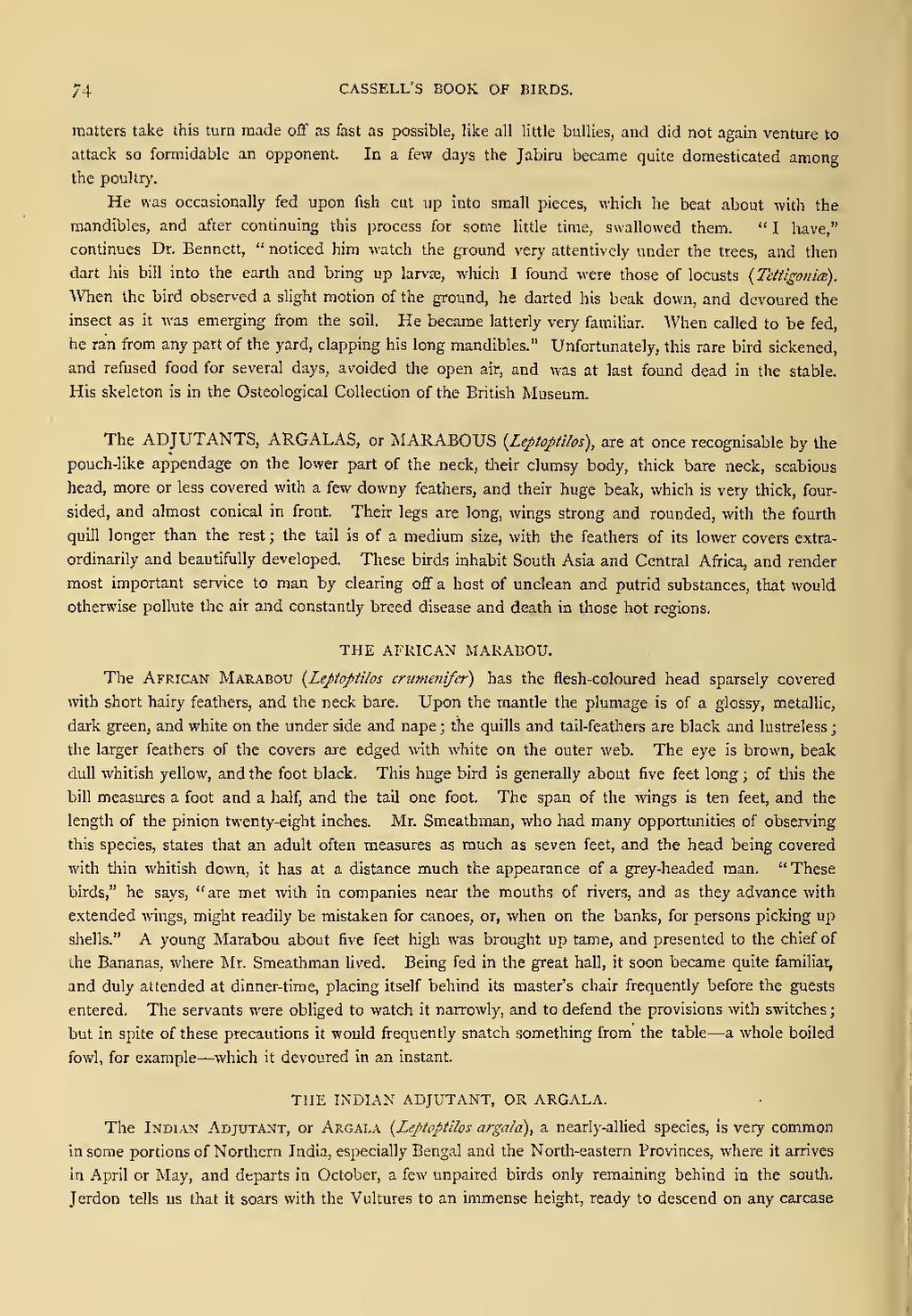matters take this turn made off as fast as possible, like all little bullies, and did not again venture to attack so formidable an opponent. In a few days the Jabiru became quite domesticated among the poultry.
He was occasionally fed upon fish cut up into small pieces, which he beat about with the mandibles, and after continuing this process for some little time, swallowed them. "I have," continues Dr. Bennett, "noticed him watch the ground very attentively under the trees, and then dart his bill into the earth and bring up larvæ, which I found were those of locusts (Tettigoniæ). When the bird observed a slight motion of the ground, he darted his beak down, and devoured the insect as it was emerging from the soil. He became latterly very familiar. When called to be fed, he ran from any part of the yard, clapping his long mandibles." Unfortunately, this rare bird sickened, and refused food for several days, avoided the open air, and was at last found dead in the stable. His skeleton is in the Osteological Collection of the British Museum.
The ADJUTANTS, ARGALAS, or MARABOUS (Leptoptilos), are at once recognisable by the pouch-like appendage on the lower part of the neck, their clumsy body, thick bare neck, scabious head, more or less covered with a few downy feathers, and their huge beak, which is very thick, four-*sided, and almost conical in front. Their legs are long, wings strong and rounded, with the fourth quill longer than the rest; the tail is of a medium size, with the feathers of its lower covers extraordinarily and beautifully developed. These birds inhabit South Asia and Central Africa, and render most important service to man by clearing off a host of unclean and putrid substances, that would otherwise pollute the air and constantly breed disease and death in those hot regions.
THE AFRICAN MARABOU.
The African Marabou (Leptoptilos crumenifer) has the flesh-coloured head sparsely covered with short hairy feathers, and the neck bare. Upon the mantle the plumage is of a glossy, metallic, dark green, and white on the under side and nape; the quills and tail-feathers are black and lustreless; the larger feathers of the covers are edged with white on the outer web. The eye is brown, beak dull whitish yellow, and the foot black. This huge bird is generally about five feet long; of this the bill measures a foot and a half, and the tail one foot. The span of the wings is ten feet, and the length of the pinion twenty-eight inches. Mr. Smeathman, who had many opportunities of observing this species, states that an adult often measures as much as seven feet, and the head being covered with thin whitish down, it has at a distance much the appearance of a grey-headed man. "These birds," he says, "are met with in companies near the mouths of rivers, and as they advance with extended wings, might readily be mistaken for canoes, or, when on the banks, for persons picking up shells." A young Marabou about five feet high was brought up tame, and presented to the chief of the Bananas, where Mr. Smeathman lived. Being fed in the great hall, it soon became quite familiar, and duly attended at dinner-time, placing itself behind its master's chair frequently before the guests entered. The servants were obliged to watch it narrowly, and to defend the provisions with switches; but in spite of these precautions it would frequently snatch something from the table—a whole boiled fowl, for example—which it devoured in an instant.
THE INDIAN ADJUTANT, OR ARGALA.
The Indian Adjutant, or Argala (Leptoptilos argala), a nearly-allied species, is very common in some portions of Northern India, especially Bengal and the North-eastern Provinces, where it arrives in April or May, and departs in October, a few unpaired birds only remaining behind in the south. Jerdon tells us that it soars with the Vultures to an immense height, ready to descend on any carcase
